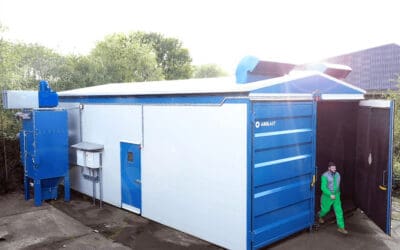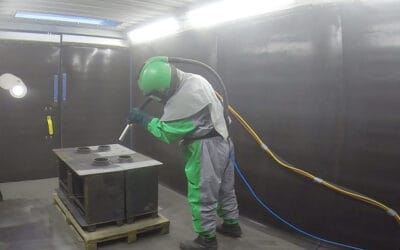Common Mistakes to Avoid When Installing a Blast Room
When installing a blast room, it’s crucial to avoid common mistakes that can lead to inefficiency, safety hazards, or costly repairs.
A well-designed and properly installed blast room ensures smoother operations, better quality outcomes, and maximized ROI. Here’s some of the most common mistakes businesses make during blast room installation and how to avoid them.
1. Underestimating Space Requirements
One of the most frequent mistakes is underestimating the amount of space required for a blast room. The size of the blast room should be proportional to the parts being blasted. If your business works with large machinery or oversized components, the blast room needs to accommodate not just the part but also provide enough room for operators to work efficiently.
It’s also essential to account for the additional space needed for equipment like ventilation systems, abrasive recovery systems, and dust collectors. Inadequate space can lead to operational inefficiencies, poor air circulation, and difficulty in maneuvering parts within the room.
Solution: Ensure your blast room’s dimensions align with the size and volume of the parts you will be handling. Consult with professionals to assess your space and project requirements accurately.
2. Neglecting Proper Ventilation and Dust Collection
A blast room without adequate ventilation and dust collection systems is a recipe for disaster. During abrasive blasting, dust, debris, and hazardous particles are generated, and without proper ventilation, these can pose serious health risks to workers and damage equipment. Moreover, poor dust collection can lower visibility within the room, leading to compromised work quality and safety concerns.
Solution: Invest in a high-quality dust collection and ventilation system that meets your business’s needs. At Airblast AFC, we offer state-of-the-art ventilation systems that ensure safe and efficient operations by removing harmful dust and debris from the workspace.
3. Improper Installation of Abrasive Recovery Systems
An abrasive recovery system is essential for cost-effective and sustainable blasting operations. However, many businesses fail to install this system properly, leading to operational inefficiencies and higher operational costs. If abrasive material is not recovered effectively, it increases waste and lowers the cost-efficiency of the process.
Common issues include installing the wrong type of recovery system or positioning it incorrectly. For example, using a pneumatic recovery system when a mechanical one is better suited to the size of your blast room could lead to long-term inefficiencies.
Solution: Choose the right abrasive recovery system based on the scale of your operations and the type of abrasive media used. Proper installation and regular maintenance are essential to ensure the system functions efficiently.
4. Overlooking Safety Measures
Safety should always be a priority, yet some businesses overlook essential safety protocols when installing a blast room. Without proper protective equipment, operator controls, and emergency exits, the risk of accidents increases significantly.
Inadequate lighting is another common issue. Poor visibility can result in operator fatigue and mistakes, potentially compromising both the quality of work and worker safety.
Solution: Install proper lighting, safety controls, and emergency protocols in your blast room. Ensure that all operators are well-trained and equipped with the necessary protective gear, including helmets, gloves, and respiratory protection.
5. Choosing the Wrong Abrasive Media
Selecting the wrong abrasive media can affect the efficiency of your blasting process and even damage the parts being blasted. Different types of media are suited for different materials and applications. For instance, steel grit is ideal for heavy-duty cleaning, while glass beads or plastic media blasting may be best for delicate surfaces.
Choosing the wrong media can lead to premature wear on equipment, improper surface finishes, or even damage to the parts being worked on. Not only does this affect the quality of your output, but it also leads to increased operational costs due to rework or equipment repairs.
Solution: Match the abrasive media to the material being blasted. Consult with experts or conduct tests to ensure that the media you select will deliver optimal results for your application.
6. Ignoring Environmental Regulations
Blast rooms often involve the use of chemicals and abrasive materials that can pose environmental risks if not properly managed. Ignoring local and federal environmental regulations can lead to fines, legal issues, or even the shutdown of operations.
For instance, some industries are required to install specific waste management systems to handle used abrasives and coatings safely. Failure to comply with these regulations not only risks legal penalties but also harms the environment.
Solution: Stay informed about the environmental regulations applicable to your industry and location. Make sure that your blast room installation includes waste disposal systems and complies with safety and environmental standards.
7. Not Allowing for Future Growth
Businesses often make the mistake of installing a blast room that fits their current needs but doesn’t account for future growth. If your production volume increases or if you start working with larger components, your blast room may quickly become obsolete, leading to costly upgrades or a need for an entirely new facility.
Solution: When designing and installing your blast room, consider your business’s growth trajectory. It may be wise to invest in a slightly larger room or modular features that can be expanded later to accommodate increased demand.
8. Failing to Train Operators
Even with the most advanced blast room systems in place, the quality of work depends on the skills of the operators. Poorly trained operators may misuse equipment, leading to inefficiencies, reduced equipment lifespan, and safety hazards.
Solution: Provide thorough training for all operators who will be using the blast room. This should cover everything from equipment operation and maintenance to safety protocols. Regular refresher courses can help ensure that all workers stay up-to-date on best practices.
Conclusion
Installing a blast room is a significant investment, and avoiding common mistakes during the installation process is critical for long-term success. By considering the factors above, you can ensure that your blast room operates efficiently, safely, and cost-effectively.
Consulting with professionals like Airblast AFC ensures that your blast room is tailored to your specific needs, allowing you to avoid costly errors and optimize your surface preparation process. For expert guidance and customized blast room solutions, contact us today.

